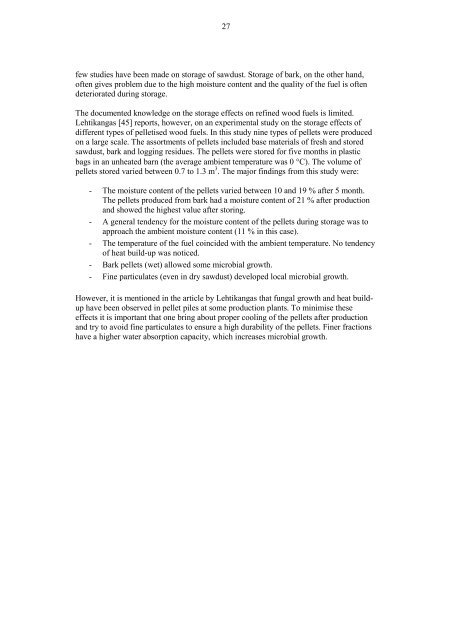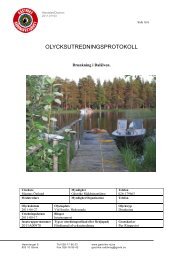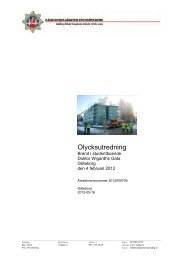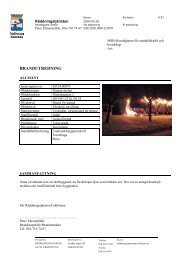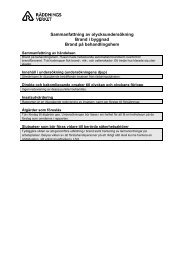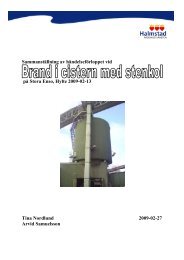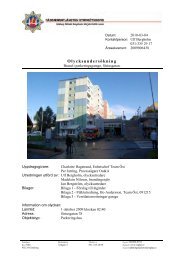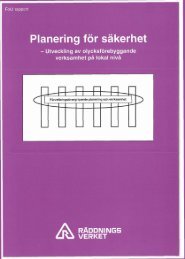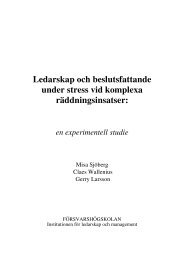26compressed, i.e., the air circulation (convective heat transfer) within the stack is low, heatbuild-up in the stack might cause auto ignition.The main factors influencing the temperature in the stack are: moisture content, the size<strong>of</strong> the pile and density; more information can e.g. be found in a report by Thörnqvist [35].There are some practical advices available regarding storage <strong>of</strong> wood fuels [30]:- If possible store dry fuels to avoid microbial growth (< 20 %).- Fuels <strong>of</strong> different qualities should never be mixed when stored.- Store preferable in small piles and during a short time.- Do not compact the material.- Avoid metal objects in the pile.- Build the stored material in elongated stacks with a base-width <strong>of</strong> twice theheight <strong>of</strong> the stack.- Examples <strong>of</strong> recommended stack-heights: wood chips from core wood – 15 m,GROT – 7 m, bark – 7 m sawdust – 6 m.Storage <strong>of</strong> refined wood fuels requires a protected environment to maintain the lowmoisture contents and the structure <strong>of</strong> the fuel. Thus, the storage conditions for thesetypes <strong>of</strong> fuels are entirely different from the storage <strong>of</strong> “wet fuels” as wood chips etc. Dueto the low moisture content the growth <strong>of</strong> microorganisms are limited, which reduces thepossibility for any temperature build-up in the stored material.3.4 <strong>Experimental</strong> storage data found in the literatureMost studies <strong>of</strong> spontaneous ignition in storage <strong>of</strong> larger quantities <strong>of</strong> materials found inthe literature is on coal. One example <strong>of</strong> such a study is the large-scale tests with coalstockpiles [36]. Investigations on self-heating were carried out with five test piles (2000-3000 tons). The effect <strong>of</strong> periodic compaction, use <strong>of</strong> a low angle slope <strong>of</strong> the side <strong>of</strong> theslope in the wind direction, pile protection by artificial barriers and covering withartificial barrier were investigated. Stainless steel probes with thermocouples andsampling ports were positioned in the piles to measure temperature and collect samples <strong>of</strong>gases (O 2 , CO 2 , CO and CH 4 ). Pile temperatures were additionally measured using aninfrared camera. This work was mainly focused on the transport <strong>of</strong> oxygen in the piles,and measures to reduce the ventilation. It was found that all three methods were effectivein reducing heat build-up in the piles, and thus reducing deterioration <strong>of</strong> the fuel. It wasfurther found that it was possible with the IR-camera to detect hot spots that would havebeen difficult to identify with the common thermocouple technique.The storage effects on wood chips stored in open piles have been studied by Lehtikangas[30]. In this study, piles with a height <strong>of</strong> seven meters and a base length <strong>of</strong> 60 meterswere studied, both regarding the influence <strong>of</strong> density <strong>of</strong> the stack and a sheltering ro<strong>of</strong>. Itwas found that the condition that deteriorated the fuel most, and that could promote autoignitionwas a compacted fuel stored in the open. In this type <strong>of</strong> stack, temperatures above300 C were found in the lower part <strong>of</strong> the stack. Pyrolysis had occurred in this part <strong>of</strong> thestack and the material was partly carbonised. Other storage studies can be found in [30]and additional information can be found in [37-44]Generally for the storage <strong>of</strong> wood fuels, there are few problems with dry wood chips dueto the low moisture content compared to fresh wood chips. Cutter shavings have also lowmoisture content, which implies lesser problems during storage. Sawdust has highermoisture content, and there might be problems associated with storage, however, very
27few studies have been made on storage <strong>of</strong> sawdust. Storage <strong>of</strong> bark, on the other hand,<strong>of</strong>ten gives problem due to the high moisture content and the quality <strong>of</strong> the fuel is <strong>of</strong>tendeteriorated during storage.The documented knowledge on the storage effects on refined wood fuels is limited.Lehtikangas [45] reports, however, on an experimental study on the storage effects <strong>of</strong>different types <strong>of</strong> pelletised wood fuels. In this study nine types <strong>of</strong> pellets were producedon a large scale. The assortments <strong>of</strong> pellets included base materials <strong>of</strong> fresh and storedsawdust, bark and logging residues. The pellets were stored for five months in plasticbags in an unheated barn (the average ambient temperature was 0 C). The volume <strong>of</strong>pellets stored varied between 0.7 to 1.3 m 3 . The major findings from this study were:- The moisture content <strong>of</strong> the pellets varied between 10 and 19 % after 5 month.The pellets produced from bark had a moisture content <strong>of</strong> 21 % after productionand showed the highest value after storing.- A general tendency for the moisture content <strong>of</strong> the pellets during storage was toapproach the ambient moisture content (11 % in this case).- The temperature <strong>of</strong> the fuel coincided with the ambient temperature. No tendency<strong>of</strong> heat build-up was noticed.- Bark pellets (wet) allowed some microbial growth.- Fine particulates (even in dry sawdust) developed local microbial growth.However, it is mentioned in the article by Lehtikangas that fungal growth and heat builduphave been observed in pellet piles at some production plants. To minimise theseeffects it is important that one bring about proper cooling <strong>of</strong> the pellets after productionand try to avoid fine particulates to ensure a high durability <strong>of</strong> the pellets. Finer fractionshave a higher water absorption capacity, which increases microbial growth.


